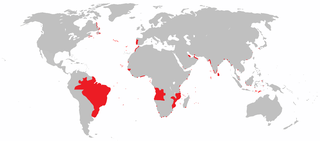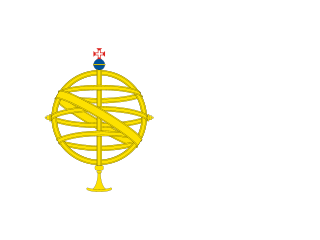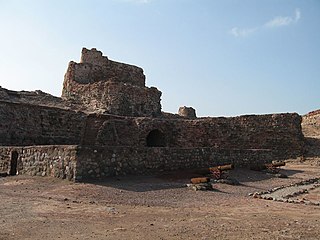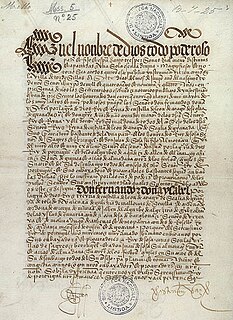 W
WThis article is a comprehensive list of all the actual possessions of the Portuguese Empire.
 W
WThe Portuguese Empire, also known as the Portuguese Overseas or the Portuguese Colonial Empire, was composed of the overseas colonies and territories governed by Portugal. One of the longest-lived empires in world history, it existed for almost six centuries, from the capture of Ceuta in 1415, to the handover of Portuguese Macau to China in 1999. The empire began in the 15th century, and from the early 16th century it stretched across the globe, with bases in North and South America, Africa, and various regions of Asia and Oceania.
 W
WThe Kingdom of Portugal in the 15th century was the first European power to begin building a colonial empire. The Portuguese Renaissance was a period of exploration during which Portuguese sailors discovered several Atlantic archipelagos like the Azores, Madeira, and Cape Verde, explored and colonized the African coast, discovered an eastern route to India that rounded the Cape of Good Hope, discovered Brazil, explored the Indian Ocean and established trading routes throughout most of southern Asia, and sent the first direct European maritime trade and diplomatic missions to Ming China and to Japan.
 W
WThe Associação Maritima e Colonial of Portugal formed in 1839. Officials included Joaquim Jose Goncalves de Mattos Correia, Joaquim Jose Cecilia Kol, and José Xavier Bressane Leite. In the 1840s it issued a monthly journal, Annaes Maritimos e Coloniaes.
 W
WThe Arquivo Histórico Ultramarino of Portugal preserves archives related to the Portuguese Empire. It is located in the Palácio da Ega on Calçada da Boa-Hora in the city of Lisbon, near the Rua da Junqueira in the parish of Alcântara. The Instituto de Investigação Científica Tropical of the governmental Ministry of Science, Technology and Higher Education administers the archives. Prior to 1973, the Overseas Ministry oversaw it.
 W
WAssimilado is the term given to African subjects of the colonizing Portuguese Empire from the 1910s to the 1960s, who had reached a level of "civilization", according to Portuguese legal standards, that theoretically qualified them for full rights as Portuguese citizens. Portuguese colonizers claimed as the goal for their assimilation practices, the "close union of races of different degrees of civilization that help and support each other loyally"; however, this notion of a "close union" differed from its practical application in the cultural and social spheres of the colonies of Portuguese Angola, Portuguese Mozambique and Portuguese Guinea.
 W
WThe Associação Maritima e Colonial of Portugal formed in 1839. Officials included Joaquim Jose Goncalves de Mattos Correia, Joaquim Jose Cecilia Kol, and José Xavier Bressane Leite. In the 1840s it issued a monthly journal, Annaes Maritimos e Coloniaes.
 W
WThe Baroque in Brazil was the dominant artistic style during most of the colonial period, finding an open ground for a rich flowering. It made its appearance in the country at the beginning of the 17th century, introduced by Catholic missionaries, especially Jesuits, who went there in order to catechize and accultate the native indigenous peoples and assist the Portuguese in the colonizing process. In the course of the Colonial period, expressed a close association between the Church and the State, but in the colony there was not a court that would serve as a patron of the arts, the elites did not bother to build palaces, or to help sponsor the profane arts, but at the end of the period, and how the religion had a strong influence on the daily lives of everyone in this group of factors derives from the vast majority of the legacy of the Brazilian Baroque period, is the sacred art: statuary, painting, and the work of carving for the decoration of churches and convents, or for private worship.
 W
WBasrur / Basroor is a village in Kundapur taluk in Udupi district of Karnataka. Historically Basrur was also called as Barcelor, Barcalor, Basnur, Bares, Abu-Sarur and Barsellor.
 W
WThe Casa da Guiné, later known as the Casa da Guiné e Mina and also referred to as the Portuguese Guinea Company, was a state-run Portuguese commercial institution, whose tasked with the management of the Portuguese Empire's economic interests and colonization in West Africa, particularly on the Gulf of Guinea, on the Gold Coast, and on the Slave Coast.
 W
WColonial Brazil comprises the period from 1500, with the arrival of the Portuguese, until 1815, when Brazil was elevated to a kingdom in union with Portugal as the United Kingdom of Portugal, Brazil and the Algarves. During the early 300 years of Brazilian colonial history, the economic exploitation of the territory was based first on brazilwood extraction, which gave the territory its name; sugar production ; and finally on gold and diamond mining. Slaves, especially those brought from Africa, provided most of the work force of the Brazilian export economy after a brief period of Indian slavery to cut brazilwood.
 W
WConquistadors were the knights, soldiers and explorers of the Spanish and the Portuguese Empire. During the Age of Discovery, conquistadors sailed beyond Europe to the Americas, Oceania, Africa, and Asia, conquering territory and opening trade routes. They brought colonialism to much of the world for Spain and Portugal in the 16th, 17th, and 18th centuries.
 W
WPortuguese discoveries are the numerous territories and maritime routes discovered by the Portuguese as a result of their intensive maritime exploration during the 15th and 16th centuries. Portuguese sailors were at the vanguard of European overseas exploration, discovering and mapping the coasts of Africa, Canada, Asia, and Brazil, in what became known as the Age of Discovery. Methodical expeditions started in 1419 along West Africa's coast under the sponsorship of prince Henry the Navigator, with Bartolomeu Dias reaching the Cape of Good Hope and entering the Indian Ocean in 1488. Ten years later, in 1498, Vasco da Gama led the first fleet around Africa to India, arriving in Calicut and starting a maritime route from Portugal to India. Portuguese explorations then proceeded to southeast Asia, where they reached Japan in 1542, forty-four years after their first arrival in India. In 1500, the Portuguese nobleman Pedro Álvares Cabral became the first European to discover Brazil.
 W
WThe Dutch–Portuguese War was an armed conflict involving Dutch forces, in the form of the Dutch East India Company and the Dutch West India Company, against the Portuguese Empire. Beginning in 1602, the conflict primarily involved the Dutch companies invading Portuguese colonies in the Americas, Africa, India and the Far East. The war can be thought of as an extension of the Eighty Years' War being fought in Europe at the time between Spain and the Netherlands, as Portugal was in a dynastic union with the Spanish Crown after the War of the Portuguese Succession, for most of the conflict. However, the conflict had little to do with the war in Europe and served mainly as a way for the Dutch to gain an overseas empire and control trade at the cost of the Portuguese. English forces also assisted the Dutch at certain points in the war. Because of the commodity at the center of the conflict, this war would be nicknamed the Spice War.
 W
WThe Fort of Our Lady of the Conception, also known as the Portuguese Castle, is a red stone fortress on Hormuz Island, Iran. It is one of the last surviving monuments of Portuguese colonial rule in the Persian Gulf. Ormuz was an important maritime city and a small kingdom near the entrance to the Persian Gulf. The original site of the city was on the north shore of the Gulf, about 30 miles east of the current Bandar Abbas. Around 1300, apparently in response to attacks from the Tartars, it moved to the small island of Gerun, which can be identified as the Organa of Nearcho, about 12 miles west and 5 miles from the coast.
 W
WFrom the restoration of the House of Braganza in 1640 until the end of the reign of the Marquis of Pombal in 1777, the kingdom of Portugal was in a period of transition. Having been near its height at the start of the Iberian Union, the Portuguese Empire continued to enjoy the widespread influence in the world during this period that had characterized the period of the Discoveries. By the end of this period, however, the fortunes of Portugal and its empire had declined, culminating with the Távora affair, the catastrophic 1755 Lisbon earthquake, and the accession of Maria I, the first ruling Queen of Portugal.
 W
WThe islands of São Tomé and Príncipe were uninhabited at the time of the arrival of the Portuguese sometime between 1469 and 1471. After the islands were discovered by the explorers João de Santarém and Pêro Escobar, Portuguese navigators explored the islands and decided they would be a good location for bases to trade with the mainland.
 W
WHonavar is a port town in Uttara Kannada district of Karnataka, India.
 W
WThe Luso-Chinese agreement of 1554 was a trade agreement between the Portuguese headed by Leonel de Sousa, and the authorities of Guangzhou headed by the Provincial Admiral Wang Bo (汪柏), which allowed for the legalization of Portuguese trade in China by paying taxes. It opened a new era in Sino-Portuguese relations, as Portuguese were until then officially barred from trading in the region. In 1517 an embassy led by Fernão Pires de Andrade to the Ming court failed and, after conflicts in 1521 and 1522, trade was conducted as smuggling and was fought by the authorities, who considered Portuguese to be "Folangji" (Frankish) pirates.
 W
WThe metropole is the homeland or central territory of a colonial empire. The term was mainly used in the scope of the British, French and Portuguese empires to designate their European territories, as opposed to their colonial or overseas territories.
 W
WThe Overseas Ministry was the department of the Government of Portugal responsible for the administration of the Portuguese Empire.
 W
WThe Capture of Ormuz was a combined Anglo-Persian expedition that successfully captured the Portuguese garrison at Hormuz Island after a ten-week siege, thus opening up Persian trade with England in the Persian Gulf. Before the capture of Ormuz, the Portuguese had held the Castle of Ormuz for more than a century, since 1507 when Afonso de Albuquerque established it in the capture of Ormuz, giving them full control of the trade between India and Europe through the Persian Gulf. According to Stephen Neill, the capture of Ormuz entirely changed the balance of power and trade.
 W
WThe Padrão Real was a cartographic work of Portuguese mastery produced secretly and maintained by the organization of the Portuguese Royal Court in the 16th century. The work was available to the scientific elite of the time, being exposed in the Casa da Índia. In the Padrão Real the new discoveries of the Portuguese were constantly added and mapped. The first Padrão Real was produced in the time of Henry the Navigator, even before the existence of the Casa da Índia.
 W
WPluricontinentalism was a geopolitical concept, positing that Portugal was a transcontinental country and a unitary nation-state consisting of continental Portugal and its overseas provinces.
 W
WIn 1932, Dr. António de Oliveira Salazar became the Prime Minister of Portugal. As the government's Minister of Finance since 1928, he was the architect of the Portuguese Colonial Act adopted in 1930, which affected Portuguese India, differentiating them from the metropolitan Portuguese people. Because of this act the Portuguese Indians lost a great deal of benefits. These included free trips to Portugal for rest and recreation, their allowances became lower than those of the white officials, and other facilities that the white Portuguese had overseas were not available to Portuguese Indians.This image of the easily adaptable Portuguese who populated the colonies of Africa and America, thanks to their lack of prejudice toward black and Indian women, was to remain one of the strongest ideological artifices of Portuguese colonisation
 W
WPortuguese colonial architecture refers to the various styles of Portuguese architecture built across the Portuguese Empire. Portuguese colonial architecture can be found in the plethora of former colonies throughout South America, North Africa, Sub-Saharan Africa, India, Oceania, and East Asia. Many former colonies, especially Brazil, Macau, and India, promote their Portuguese colonial architecture as major tourist attractions.
 W
WThe Portuguese Colonial War, also known in Portugal as the Overseas War or in the former colonies as the War of Liberation, was a thirteen year long conflict fought between Portugal's military and the emerging nationalist movements in Portugal's African colonies between 1961 and 1974. The Portuguese corporatist authoritarian regime at the time, the Estado Novo, was overthrown by a military coup in 1974, and the change in government brought the conflict to an end. The war was a decisive ideological struggle in Lusophone Africa, surrounding nations, and mainland Portugal.
 W
WThe Portuguese East India Company was a short-lived ill-fated attempt by Philip III of Portugal to create a national chartered company to look after interests in Portuguese India in the face of encroachment by the Dutch and English following the personal union of the Portuguese and Spanish Crowns.
 W
WThe spice trade refers to the trade between historical civilizations in Asia, Northeast Africa and Europe. Spices such as cinnamon, cassia, cardamom, ginger, pepper, and turmeric were known and used in antiquity for commerce in the Eastern World. These spices found their way into the Near East before the beginning of the Christian era, where the true sources of these spices were withheld by the traders and associated with fantastic tales.
 W
WThe Treaty of Tordesillas, signed at Tordesillas in Spain on June 7, 1494, and authenticated at Setúbal, Portugal, divided the newly-discovered lands outside Europe between the Portuguese Empire and the Spanish Empire, along a meridian 370 leagues west of the Cape Verde islands, off the west coast of Africa. That line of demarcation was about halfway between the Cape Verde islands and the islands entered by Christopher Columbus on his first voyage, named in the treaty as Cipangu and Antilia.